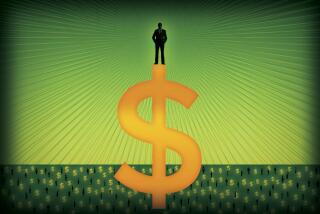The one CEO perk that’s not fading away

An executive physical allows busy top managers to see a variety of doctors and get a battery of tests performed at one time. In 2013, 32% of companies offered it, according to consulting firm Willis Towers Watson.
- Share via
Since 2006, when the Securities and Exchange Commission began requiring companies to disclose more detail about executive compensation, perks for top managers have been under attack. Under pressure from investors and the fear of embarrassing optics for companies, many have quietly vanished. Country club memberships have all but gone the way of the three-martini lunch. Allowances for company cars? So very 2005.
But one perk with staying power, executive compensation consultants say, is the executive physical. The often deluxe checkup allows busy top managers to see a variety of doctors and get a battery of tests performed at one time, whether in top-notch medical centers such as the Mayo Clinic or luxurious digs such as Canyon Ranch.
In 2008, roughly 22% of companies in the Fortune 500 said they paid for the perk, consulting firm Willis Towers Watson reported. By 2013, 32% of companies offered it.
“When you look at executive perquisites, companies really pared back,” said Rob Mustich, a managing director at Willis Towers Watson. “But the executive physical is one perk that remains common.”
Why has this perk held strong? After all, with median pay for chief executives reaching $13.6 million in 2015, according to some estimates, $5,000 for a VIP medical visit is pocket change for many top executives. And it’s not as though boards are getting an inside look at the CEO’s health in return.
“The board or the company would have no right to the employee’s protected health information under HIPAA and other privacy rules,” said Robin Schachter, a partner in the executive compensation group of Akin Gump.
The most obvious reason they remain is that a CEO’s health is a risk factor. Consider what happened when, just one month after taking the top job at United Continental Holdings Inc., Oscar Munoz suffered a heart attack. It came in the wake of a corruption probe at the airline that caused his predecessor to resign, and the stock fell 3% before recovering.
An interim leader was installed, and then in January the company announced Munoz had heart transplant surgery, and the stock slipped again. He is expected to return to the job early in the second quarter, the company has said.
An efficient, comprehensive, A-to-Z checkup could mean it’s less likely something will be missed.
“It’s the difference between a pop quiz and a take-home exam,” said David Wise, U.S. market leader for the human resources consulting firm Hay Group. “They pick up things you wouldn’t always expect.” (United’s 2015 proxy, released before Munoz became CEO, shows the company paid for executive physicals; a spokesperson would not disclose whether Munoz had one.)
Disclosing the cost of the physical in company proxies telegraphs to investors that the CEO’s health is a priority.
“What they’re really buying is shareholder confidence,” Wise said.
Anadarko Petroleum Corp. chief R.A. Walker was reimbursed $15,868 for his executive physical in 2014, the company’s proxy states. A spokesperson said the physical was “intended to be thorough, relatively low-cost and preventive actions to help ensure early detection and protect the interests of our shareholders.”
“CEOs’ health is material,” Charles Elson of the University of Delaware said. And in the grand scheme of executive compensation, “it’s just not very much money. More important, it’s totally relevant.”
Providers of executive physicals report mixed results on their business. Canyon Ranch global sales director Molly Anderson said that inquiries from corporations are up. But they’ve also seen a shift in their business, with more interest in a shorter, two-night program (price: $4,355 plus the cost of accommodations).
James Tuck, manager of the Scripps Executive Health program in San Diego, said his unit has seen more reluctance and caution from potential customers.
“Companies are watching how they spend their benefits dollars,” Tuck said. The standard program at Scripps involves a daylong visit that includes visits with an internal medicine doctor, a skin cancer screening with a dermatologist and a range of heart tests, as well as counseling for nutrition, stress and exercise. It runs $3,070 for men and $3,700 for women.
What information do boards get about CEOs’ health? Incoming executives may be asked about it. Employment agreements often refer to the appointed CEO acknowledging a clean health history.
One certainty: The globetrotting nature of any high-level manager’s job, the 24/7 hours and the intensity of the work are bound to tax a person. As former IBM Corp. chief Sam Palmisano said last year, his doctor saw real improvements in his health after he left the top ranks.
“You don’t realize it at the time because you just do it,” he said. “You grind away. Everyone wants the organization to be successful, so you work hard. But you forget how much of that you internalize and how much stress it puts into you, and the effects it has on your health over time.”
McGregor writes a daily column analyzing leadership in the news for the Washington Post’s On Leadership section.
More to Read
Inside the business of entertainment
The Wide Shot brings you news, analysis and insights on everything from streaming wars to production — and what it all means for the future.
You may occasionally receive promotional content from the Los Angeles Times.










